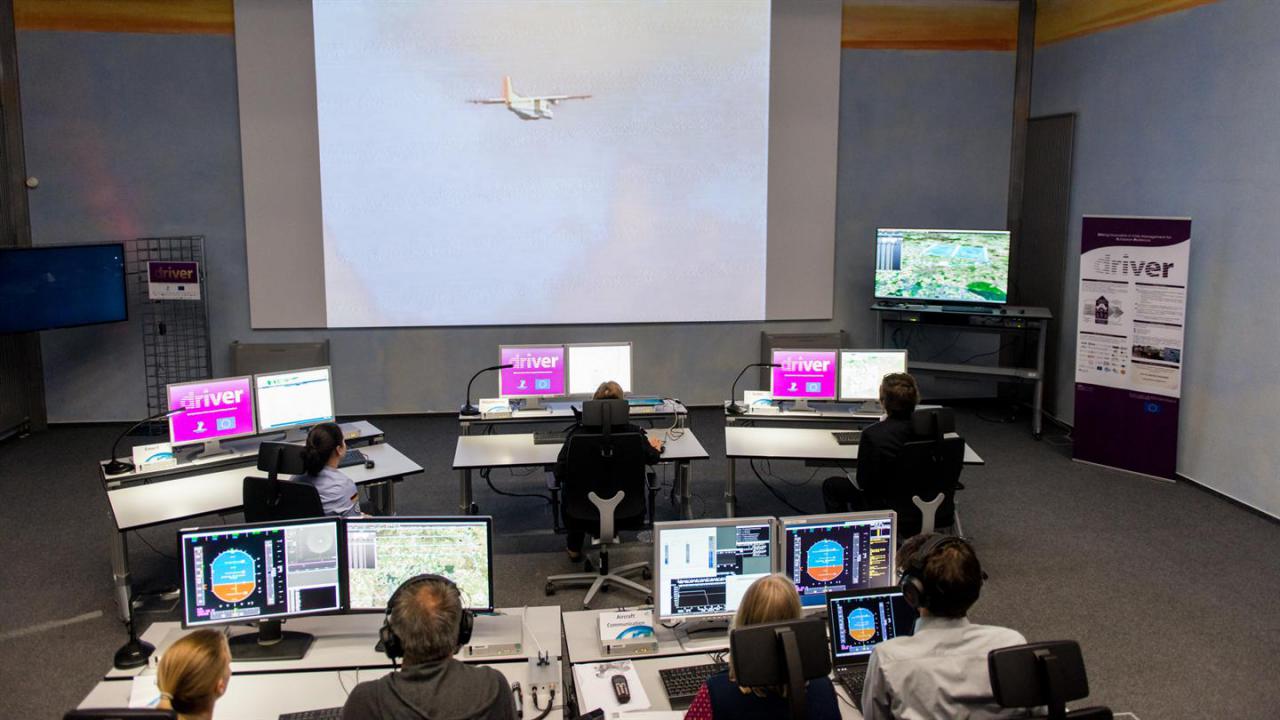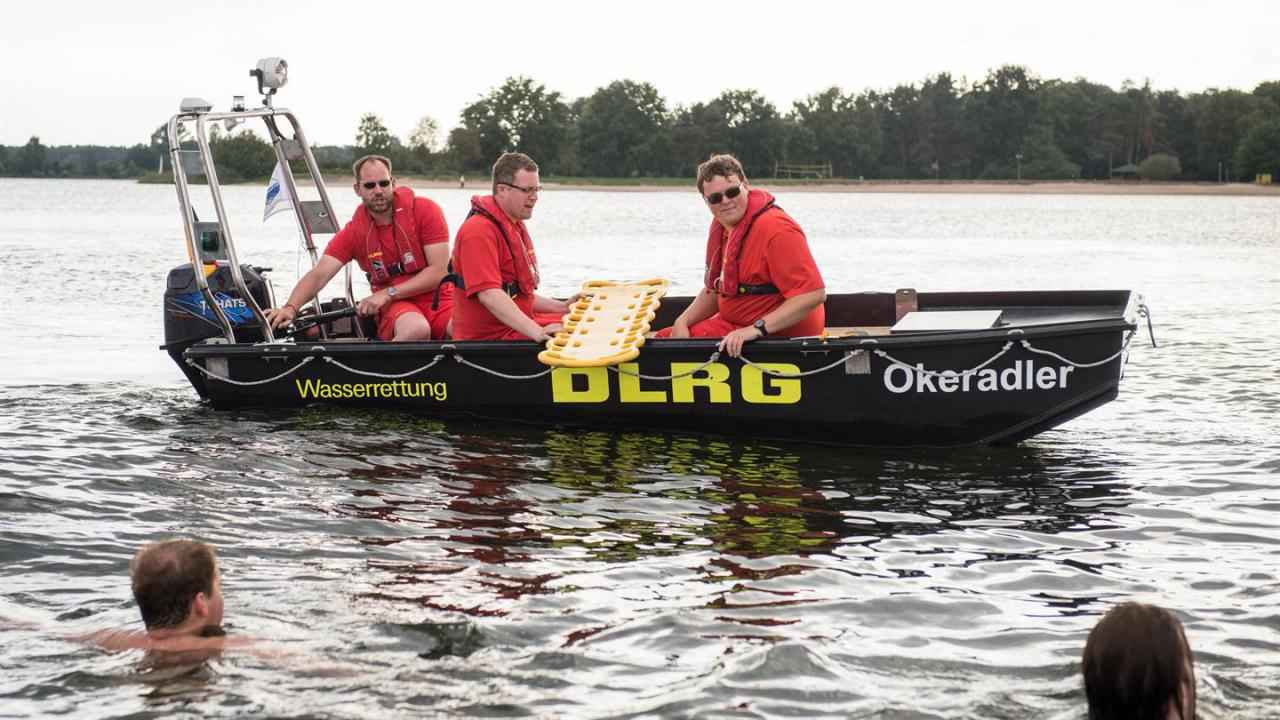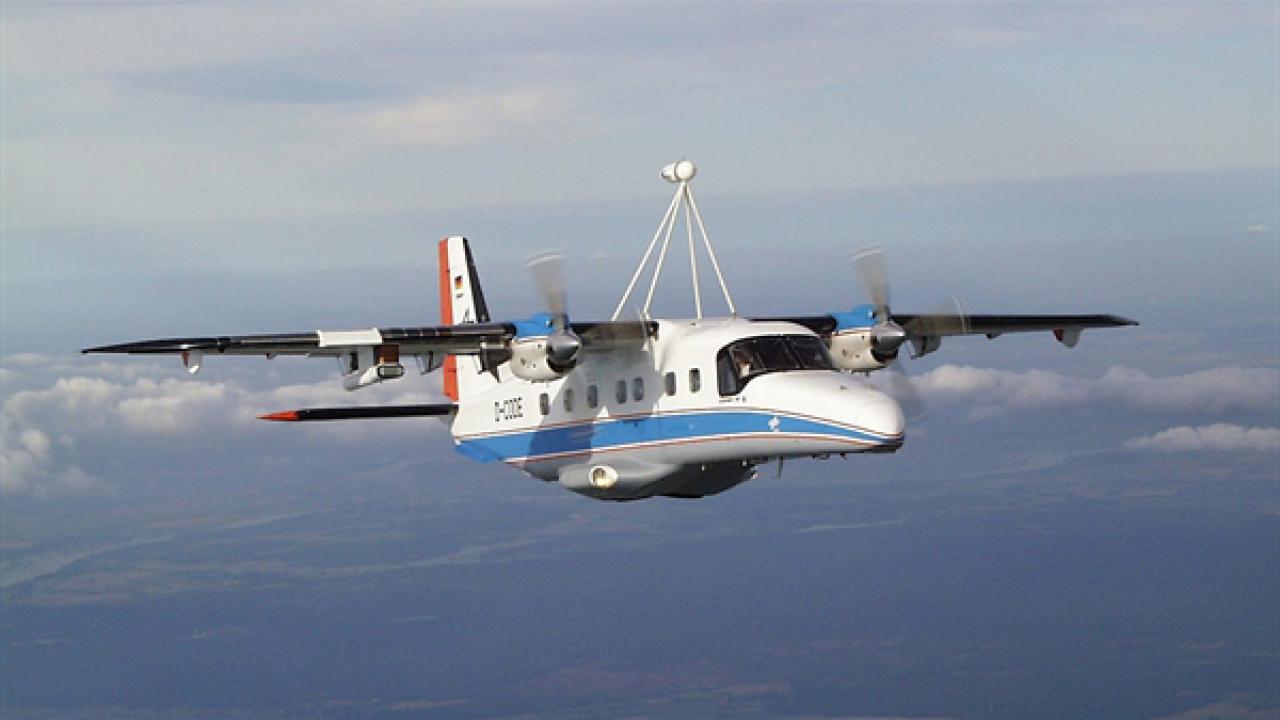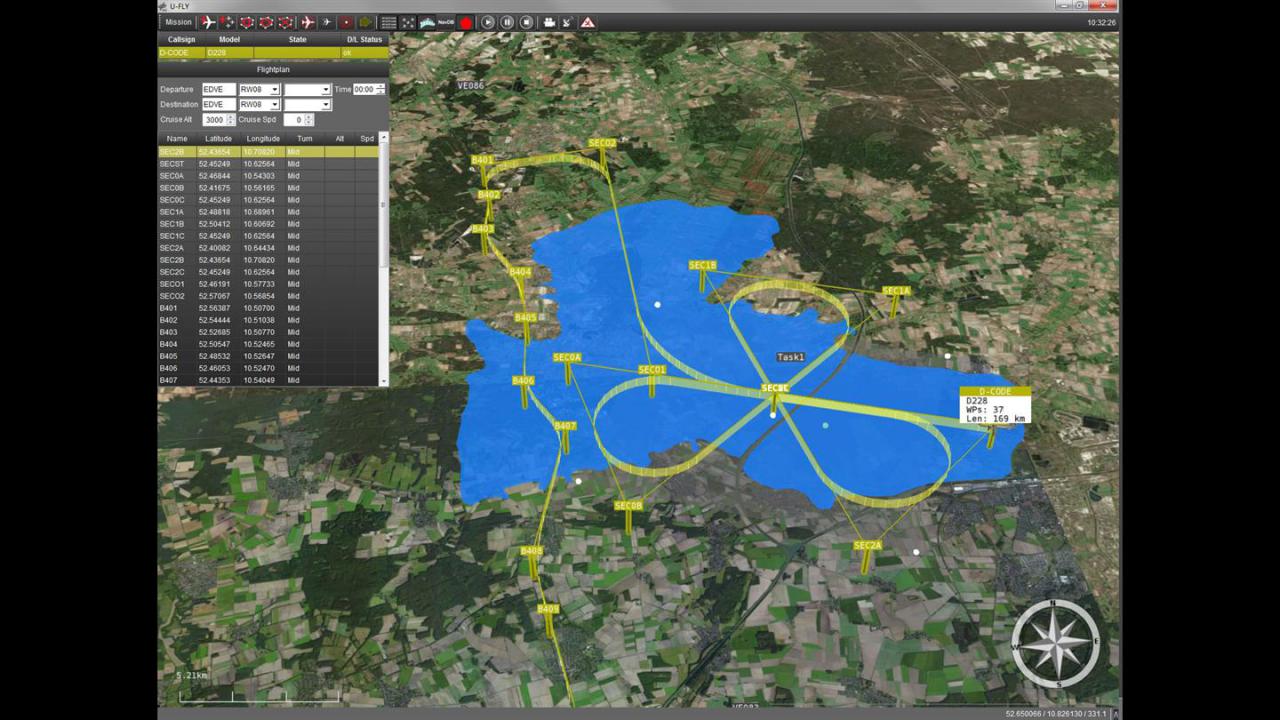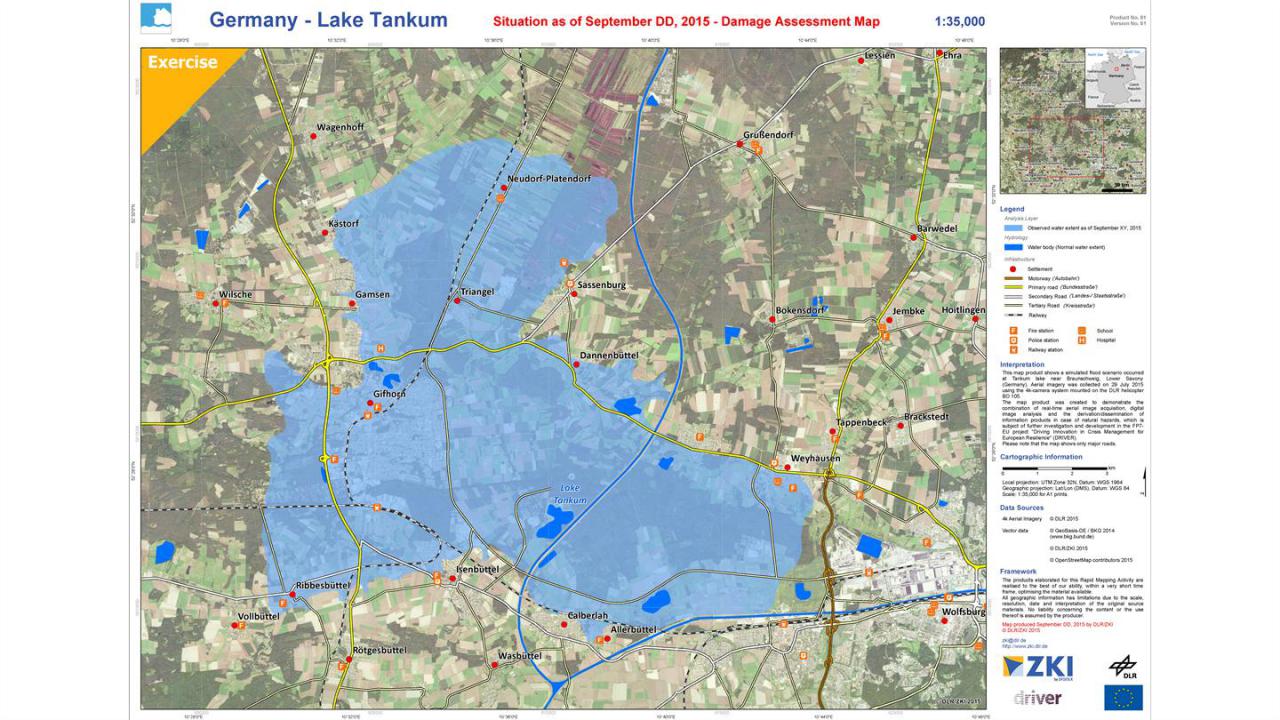From 9 September 2015, test flights are taking place on three consecutive days in a simulated disaster scenario as part of the EU's 'Driving Innovations in Crisis Management for European Resilience' (DRIVER) project. Harrowing scenes are being simulated in Braunschweig on those days. A major flood has covered a wide area around the Tankumsee, a lake near Gifhorn; surrounding roads are also affected and people are stranded in the water. But during this practice, the flood only exists in a digital form on the screens of the Air Traffic Validation Center operated by the German Aerospace Center (Deutsches Zentrum für Luft- und Raumfahrt; DLR). This is where a crisis management centre has been set up for the test campaign.
Meanwhile, DLR's D-CODE research aircraft, a Do-228, is circling the Tankumsee. As it does so, it is supplying the U-FLY ground station at the DLR Institute of Flight Guidance with situational images in real time – information that the rescue workers use to coordinate the disaster response logistics. This technology is intended to make a critical contribution to disaster relief in Europe.
Disaster management for Europe
Together with 36 organisations from 13 EU countries, including the German Federal Agency for Technical Relief (Technische Hilfswerk; THW), Thales, Frequentis, the Fraunhofer Association and members of the International Red Cross, DLR is working on a pan-European system for improved crisis management under the EU's DRIVER project. "However, this is not just about the development of new software systems; rather, in DRIVER we want to use close integration of rescue and relief resources to develop a shared, international understanding for improved crisis management," says DLR project leader Dagi Geister from the Institute of Flight Guidance.
To this end, various disaster management technologies and systems are being brought together in the current experiment campaign and tested for the first time as a complete system in a realistic scenario. The aims of the flight tests are to capture the magnitude of a flood disaster using aerial images, to analyse the transport situation and to identify rescue routes. In addition, people in distress can be automatically detected in the images using special software, and then rescued by volunteer lifeguards. To make the simulation of the flood situation as realistic as possible, staff at the Center for Satellite Based Crisis Information (Zentrum für satellitengestützte Kriseninformation; ZKI) have used historical data to generate a 'flood mask' that is overlaid onto the aerial images obtained.
Rescue for tomorrow – fast, efficient and uncrewed?
A special focus in the current tests is the use of uncrewed air vehicles called Remotely Piloted Aircraft Systems (RPAS) that are controlled and monitored from the ground. A critical benefit in the use of RPAS in disaster situations is that they are capable of generating up-to-date, high-resolution aerial images of areas that are difficult or dangerous for rescue workers to reach. In the event of tsunamis, storms or floods, RPAS can use sequences of aerial images to render the course and monitor the development of a visible disaster. Furthermore, they assist the aid workers by providing visual information from the images regarding the transport situation and infrastructure – important data for accurate deployment planning.
Autopilot at the controls
For the flight tests above the Tankumsee, a modified experimental system has been installed in the DLR's D-CODE research aircraft. This enables entire flight paths from take-off to landing, plus control instructions (such as altitude and course changes), to be sent directly to the aircraft from the ground via a data link. However, a backup crew is always present on board in case of an emergency. The mission and flight planning all takes place at the crisis centre in Braunschweig, and the search patterns that the aircraft is currently flying over the area have been calculated in advance. "Nevertheless, we are able to intervene during the flight and alter the flight path as required. This means that we can react quickly to specific situations, such as necessary avoidance manoeuvres around nearby air traffic or detecting people swimming in the water," explains Geister. In fact, five volunteers are swimming in the water alongside a rescue boat from the German Lifesaving Association (Deutsche Lebens-Rettungs-Gesellschaft; DLRG) during the overflights.
During the aerial imaging, the D-CODE aircraft will be using technology that has already been successfully tested in the VABENE transport project. The integrated 3-head (3K) resolution camera system can cover an 80 square kilometre area in approximately two minutes. The software generates geo-referenced aerial images of this area and transmits the results to the ground via a data link. Image analysis enables the system to automatically detect and identify objects such as vehicles and people. "As soon as we receive the data in the crisis centre in Braunschweig and identify people in distress, potential rescue routes are calculated and this information is forwarded to the DLRG's volunteer helpers, who are on the Tankumsee in a boat with two lifeguards during the exercise. As a result, following detection, they can get to work almost immediately and rescue our 'flood victims' from the water," says Geister, explaining the procedure.
Overflights in three stages
Deployment of DLR's D-CODE research aircraft comes in three stages. Firstly, there is a wide-scale overflight of the area around the Tankumsee for a general situation report. This determines not only the extent of the flood, but also uses images of the A2/B4/Braunschweig triangle to capture the transport infrastructure. Then the 'Tankumsee crisis area' is imaged more accurately in three flight circuits. Thirdly, in the test flights, the real-time transport situation on the nearby major road systems, the A2 and B4, is captured so rescue routes can be analysed. The DLR Institute of Transportation Systems in Berlin generates an up-to-date image of the traffic situation for the affected region from the incoming data. This data will later help the rescue workers coordinate the disaster response logistics. In the current experimental flight, this is not yet being used on site. In the large-scale demonstration campaign at the end of the DRIVER project in 2017 and 2018, rescue workers will not only be following the scenario on their computers but will be deployed themselves. "One goal of the flight experiment is to demonstrate the valuable contribution that RPAS can make in crisis management for natural disasters," explains Geister. "Maybe in future, victims of disasters in inaccessible areas can be helped by unmanned aircraft, with the targeted, fast provision of relief supplies such as food, water or medications."
The work on the DRIVER project is being conducted as part of DLR's security research In the security research area of DLR, research and development activities with defence and security relevance are planned and implemented in consultation with partners in government, academia, industry and international organisations. The cross-discipline nature of security research links the core competencies of the established DLR programmes in aeronautics, space, energy and transport. Overall, as part of their security-related activities, more than 20 DLR institutes and facilities provide contributions to the development, testing and evaluation of technologies, systems and concepts, as well as analysis and evaluation of safety-related applications.

